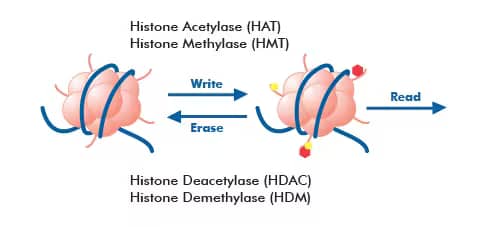Epigenetic Machinery
Three main protein groups control major epigenetic mechanisms targeting DNA, histones and nucleosome positioning. Genome-wide epigenetic marks introduced by these proteins control various biological processes including gene expression, DNA-protein interactions, chromosomal stability, DNA repair, DNA replication, chromosome structure and recombination events during meiosis.
DNA Methyltransferases
DNA methylation represents a principal and common epigenetic modification. DNA methyltransferases (DNMTs), including DNMT1, DNMT3a and DNMT3b, catalyze the methylation of CpG dinucleotides by addition of a methyl group from S-adenosyl-L-methionine to the 5’ carbon position of cytosine. DNMTs are responsible for setting and maintaining DNA methylation patterns. DNMT3a and DNMT3b methylate previously unmethylated CpG sequences and are classified as de novo methyltransferases. In contrast, DNMT1, the most prevalent methyltransferase in mammals, ensures the maintenance of methylation tags onto new DNA strands during replication.
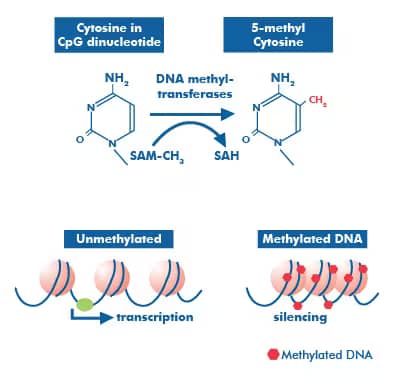
Methylation of DNA by DNMTs leads to gene silencing via different mechanisms including:
- Methylated CpGs prevent binding of specific transcription factors to gene regulatory regions thereby inhibiting transactivation
For example, this mechanism affects the binding of HIF-1, Sp1 and Sp3
- Transcriptional repressors bind preferentially to methylated CpGs impeding access to gene regulatory regions
For example, recruitment of histone deacetylases (HDACs) by methyl-CpG binding protein (MeCP2) and methyl-CpG binding domain protein 2 (MBD2), alters the chromatin’s conformation and makes promoter regions less accessible to transcriptional activators.
DNMT1 Protein Domains

DNMT1 is predominantly localized to the nuclei of cells undergoing growth phases (G1 and G2) and is highly expressed during chromosome duplication (S phase) when it targets replication foci. DMAP1 binding site (DMAP); PCNA binding motif (PCAN); Replication foci targeting sequence (RTFS); zinc binding domain (CxxC); Bromo-adjacent homology domain (BAH).
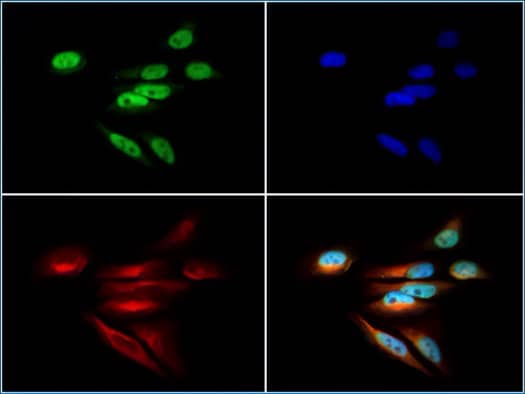
Immunocytochemistry/Immunofluorescence: DNMT1 Antibody [NB100-264] was tested in HeLa cells at a 1:50 dilution, Dylight 488 (green). α-tubulin and nuclei were counterstained, Dylight 550 (red) and DAPI [NBP2-31156] (blue), respectively.
DNMT3 Protein Domains

DNMT3a and DNMT3b are DNA modifying proteins mostly involved in the methylation of CpG sequences during embryogenesis. Different from DNMT1, DNMT3 enzymes do not target hemimethylated DNA. Expression of DNTM3 enzymes is induced at embryonic stages and downregulated in differentiated cells. Pro-Trp-Trp-Pro domain (PWWP); ATRX-DNMT3-DNMT3L Cys-rich-zinc-finger binding domain (ADD).
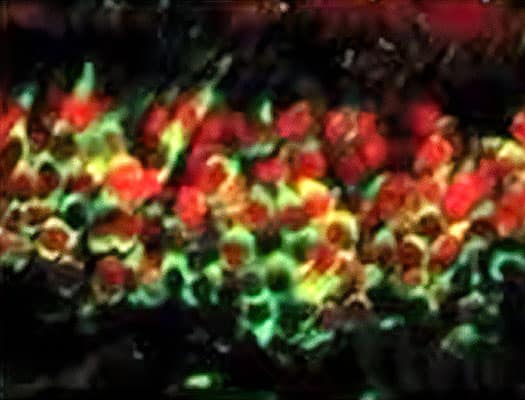
Immunocytochemistry/Immunofluorescence: DNMT3A Antibody (64B1446) [NB120-13888] - Expression of Dnmt3a in the nuclei of post-mitotic neurons in the olfactory epithelium (OE). DNMT3a (red) is co-expressed with neuron-specific tubulin (green) throughout the development of the olfactory epithelium. (Data courtesy of A. Jane Roskams, University of British Columbia).
Histone ModifiersThe primary structural unit in chromatin is the nucleosome which consists of a histone core particle (two dimers of H2.A-H2.B and an H3-H4 tetramer) surrounded by DNA (~150 nucleotide base pairs). Additionally, Histone 1 (H1) associates with linker DNA between the nucleosomes. Histones are the target of a variety of post-translational covalent and reversible modifications including:
|
Writers and erasers help determine chromatin’s transcriptional state through a dynamic process of post-translational covalent tags-addition and -removal. Specificity for the addition or removal of marks varies among family members, however HMT and HDM members generally target specific histones and residues.
| Histone Modifying Enzyme Class | Tag-Modification | Activity | Representative Histone Modifying Enzymes |
|---|---|---|---|
| HATS | Acetyl addition | Induce chromatin's open conformation | Gcn5/PCAF, MYST |
| HMTs | Methyl addition | Associated with transcriptional activation and silencing | Set1, MLL, Set7/9 and SMYD3 |
| HDACs | Acetyl removal | Induce chromatin condensation | HDACs Class I-IV |
| HDMs | Methyl removal | Associated with transcriptional activation and silencing. Removal of methyl tags from lysine or arginine residues | K: LSD1, JHDM1A, JMJD2, UTX, JMJD3 R: JMJD6 |
Readers are chromatin-associated proteins which recognize specific epigenetic modifications and influence transactivation via different mechanisms including:
- Induction of nucleosome cross-linking
- Modulation of transcription factor and RNA polymerase complex access
- Promotion of additional chromatin post-translational modifications
Different families of readers have been identified by their unique modified-histone binding domains or “binding modules”. Readers interact specifically with modified histone sequences as part of multiprotein complexes and help modulate transactivation, either activating or repressing expression.
| Readers Binding Domains | Representative Chromatin-Associated Proteins |
|---|---|
| Bromodomain | SNF2, TAF(II)250, HRX/MLL, PCAF |
| Chromodomain | Polycomb, HP1 |
| Tudor | 53BP1 |
| Set | Suv39H1, HRX/MLL, G9a |
| PHD Finger | RAG2 |
Chromatin-associated Proteins
| Transcriptional Activating Mark: K4me3 | Transcriptional Repressive Mark: K9me3 |
|---|---|
| BPTF | HP1 alpha |
| SGF29 | HP1 beta |
| PHF8 | HP1 gamma |
| RAG2 | CDYL |
| TFIID | ATRX |
| TAF3 | MPP8 |
| ING3 | UHRF1 |
Histone Code
The sum of DNA-associated histones and histone marks, often referred to as the “histone code”, influence chromatin’s structure and function. Structurally, the histone code plays a key role in DNA folding and the extent of chromatin condensation. For example, specific histone tags are associated with euchromatin or heterochromatin which are transcriptionally active or inactive chromatin states respectively.
| Euchromatin | Heterochromatin* |
|---|---|
| H3K4ac, H3K4me2, H3K4me3 | H3K9me, H3K9me2, H3K9me3 |
| H3K9me3 | H3K27me, H3K27me3 |
| H3K36ac, H3K36me | H4K20me, H4K20me2, H4K20me3 |
| H3K79ac, H3K79me2, H3K79me3 |
Antibodies to Histone Targets Validated for Single Cell Western
| Milo Validated Antibodies | Host Species |
|---|---|
| Histone H3 | Sheep |
| Histone H3 | Mouse |
| H3K79me2 | Rabbit |
Beyond transcriptional regulation, the histone code, by virtue of its effects on chromatin’s structure influences various DNA-related functions including:
- DNA repair
- DNA replication
- Recombination events
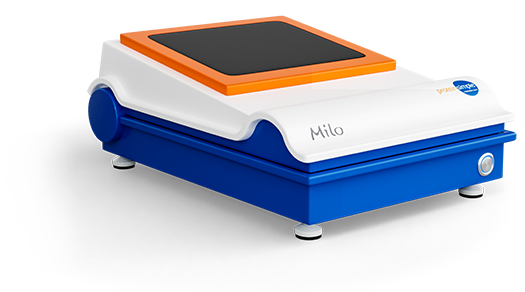
Milo™ Single Cell Westerns
- Step away from population-level resolution of western blotting and off-target binding of flow cytometry, and embrace the single-cell revolution.
- Resolve single-cell profile heterogeneity in your sample and have confidence when optimizing your cell culture conditions.
Chromatin Remodelers
The position of the nucleosome influences the access of transcription factors to a gene’s regulatory region and therefore is a key determinant of gene expression. Nucleosome positioning is regulated by four subfamilies of chromatin remodeling protein complexes which depend on ATP hydrolysis to mediate various functions:
- change the position of histones within nucleosomes
- removal of histones
- introduction of histone variants
| Subfamilies of Chromatin Remodelers | Functions |
|---|---|
| SWI/SFN (Switching/Sucrose Non-fermenting) | Nucleosome remodeling, DNA repair, differentiation, proliferation |
| ISWI (Imitation Switch) | Nucleosome spacing, DNA damage repair, DNA transcription and replication |
| CHD (Chromodomain-Helicase-DNA binding) | Nucleosome structure and density, DNA damage repair, DNA transcription |
| INO80 (Inositol Requiring) | Transcriptional regulation, DNA repair, recombination, and replication |
Histone Variants
In addition to the four major histones that conform the nucleosome, histone variants have been identified in different species including mammals. Histone variants are incorporated into the chromatin independently of DNA-replication and play key roles in epigenetic mechanisms regulating gene expression. The sequence and domains of histone variants are not overtly different from that of canonic nucleosome histones. The mechanisms by which histone variants alter nucleosome structure or chromatin organization are not fully resolved.
| Histone Variants | Activity |
|---|---|
| CENPA | Centromere Protein A; H3 variant with centromere function |
| H2A.X | H2A variant, marks damaged DNA and induces repair mechanisms |
| H2A.Z | H2A variant frequently found in association with euchromatin; associated with heterochromatin during embryonic development |
| H3.3 | H3 variant in nucleosomes of non-dividing cells; involved in senescence epigenetic events; important in the brain for neuronal plasticity |
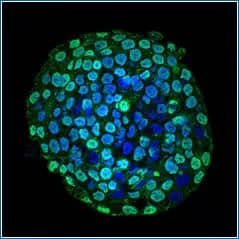
CENPA Expression. Immunocytochemistry/Immunofluorescence: CENPA Antibody (5A7-2E11) [NBP2-12892] - Tissue: Colon cancer cell line (HT-29). Species: Human. Fixation: 4% Formaldehyde for 15 min at RT. Primary Antibody: Mouse Anti-CENP-A Monoclonal Antibody at 1:100 for 60 min at RT. Secondary Antibody: Goat Anti-Mouse ATTO 488 at 1:100 for 60 min at RT. Counterstain: DAPI (blue) nuclear stain at 1:5000 for 5 min RT. Localization: Nucleus. Magnification: 60X.
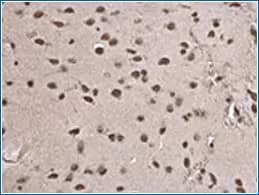
H3.3 Variant Brain Expression. Immunohistochemistry-Paraffin: Histone H3.3 Antibody [NBP2-14981] - Sample: Paraffin-embedded mouse middle brain. Histone H3.3 antibody dilution: 1:500.
